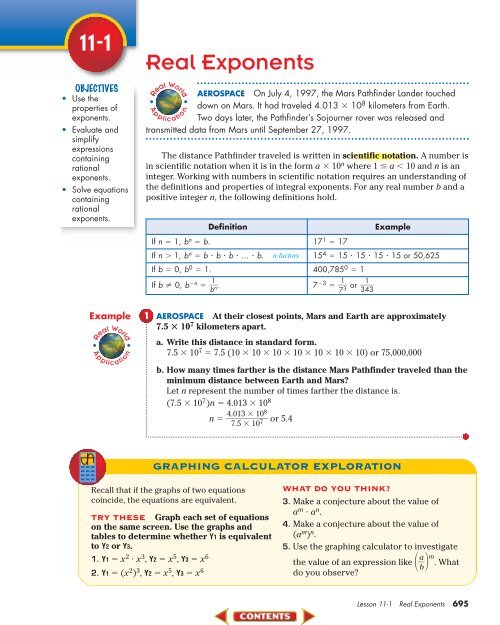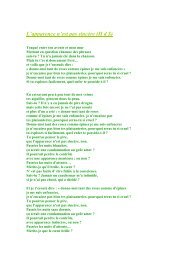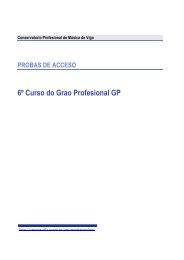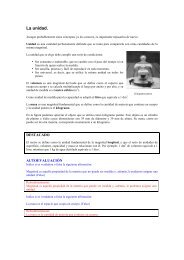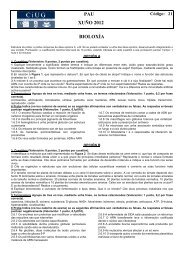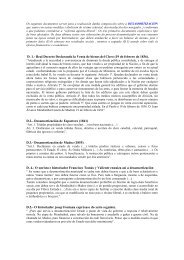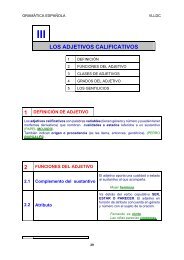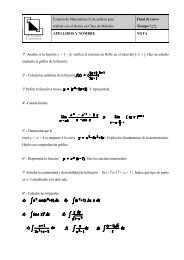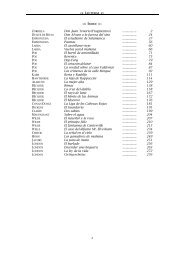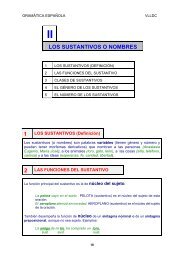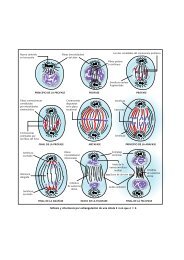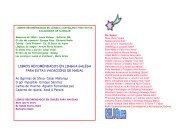Real Exponents
Real Exponents
Real Exponents
Create successful ePaper yourself
Turn your PDF publications into a flip-book with our unique Google optimized e-Paper software.
11-1<br />
OBJECTIVES<br />
• Use the<br />
properties of<br />
exponents.<br />
• Evaluate and<br />
simplify<br />
expressions<br />
containing<br />
rational<br />
exponents.<br />
• Solve equations<br />
containing<br />
rational<br />
exponents.<br />
<strong>Real</strong> <strong>Exponents</strong><br />
AEROSPACE On July 4, 1997, the Mars Pathfinder Lander touched<br />
down on Mars. It had traveled 4.013 10 8 kilometers from Earth.<br />
Two days later, the Pathfinder’s Sojourner rover was released and<br />
transmitted data from Mars until September 27, 1997.<br />
<strong>Real</strong> World<br />
A p plic atio n<br />
The distance Pathfinder traveled is written in scientific notation. A number is<br />
in scientific notation when it is in the form a 10 n where 1 a 10 and n is an<br />
integer. Working with numbers in scientific notation requires an understanding of<br />
the definitions and properties of integral exponents. For any real number b and a<br />
positive integer n, the following definitions hold.<br />
Definition<br />
If n 1, b n b. 17 1 17<br />
Example<br />
If n 1, b n b b b … b. n factors 15 4 15 15 15 15 or 50,625<br />
If b 0, b 0 1. 400,785 0 1<br />
If b 0, b n 1<br />
b n. 7 3 1 1<br />
7<br />
3<br />
or 3 43 <br />
Example 1<br />
<strong>Real</strong> World<br />
A p plic atio n<br />
AEROSPACE At their closest points, Mars and Earth are approximately<br />
7.5 10 7 kilometers apart.<br />
a. Write this distance in standard form.<br />
7.5 10 7 7.5 (10 10 10 10 10 10 10) or 75,000,000<br />
b. How many times farther is the distance Mars Pathfinder traveled than the<br />
minimum distance between Earth and Mars?<br />
Let n represent the number of times farther the distance is.<br />
(7.5 10 7 )n 4.013 10 8<br />
n 4. 013<br />
108<br />
<br />
7.<br />
5 107<br />
or 5.4<br />
GRAPHING CALCULATOR EXPLORATION<br />
Recall that if the graphs of two equations WHAT DO YOU THINK?<br />
coincide, the equations are equivalent.<br />
TRY THESE Graph each set of equations<br />
on the same screen. Use the graphs and<br />
tables to determine whether Y1 is equivalent<br />
to Y2 or Y3.<br />
1. Y1 x 2 x 3 , Y2 x 5 , Y3 x 6<br />
2. Y1 (x 2 ) 3 , Y2 x 5 , Y3 x 6<br />
3. Make a conjecture about the value of<br />
a m a n .<br />
4. Make a conjecture about the value of<br />
(a m ) n .<br />
5. Use the graphing calculator to investigate<br />
the value of an expression like a b m . What<br />
do you observe?<br />
Lesson 11-1 <strong>Real</strong> <strong>Exponents</strong> 695
The Graphing Calculator Exploration leads us to the following properties of<br />
exponents. You can use the definitions of exponents to verify the properties.<br />
Properties of <strong>Exponents</strong><br />
Suppose m and n are positive integers and a and b are real numbers.<br />
Then the following properties hold.<br />
Property Definition Example<br />
Product a m a n a m n 16 3 16 7 16 3 7 or 16 10<br />
Power of a Power (a m ) n a mn (9 3 ) 2 9 3 2 or 9 6<br />
Power of a Quotient a b m a b m m<br />
, where b 0 3 4 5 3 4<br />
5<br />
5<br />
243<br />
or <br />
1 024<br />
Power of a Product (ab) m a m b m (5x) 3 5 3 x 3 or 125x 3<br />
Quotient<br />
a m<br />
an a m n , where a 0 1 56<br />
<br />
152<br />
15 6 2 or 15 4<br />
Examples 2<br />
Evaluate each expression.<br />
a. 24 2<br />
<br />
8<br />
25<br />
24 <br />
2<br />
2 8<br />
5<br />
b. 2 5 1<br />
2 (4 8) 5 2 5 1 b n b<br />
1n <br />
2 7<br />
128<br />
Product and<br />
Quotient<br />
Properties<br />
<br />
1<br />
2 5 <br />
5 2 <br />
3<br />
Simplify each expression.<br />
a. (s 2 t 3 ) 5<br />
(s 2 t 3 ) 5 (s 2 ) 5 (t 3 ) 5 Power of<br />
a Product<br />
s (2 5) t<br />
(3 5) Power of<br />
a Power<br />
s 10 t 15<br />
3 y<br />
) 3<br />
3<br />
x<br />
b. (x<br />
4<br />
x y<br />
( x4 ) 3 x y<br />
x1<br />
2<br />
x (3 12) y<br />
3<br />
x 9 y or x<br />
y9 <br />
Power of a Power<br />
Quotient Property<br />
Expressions with rational exponents can be defined so that the properties of<br />
integral exponents are still valid. Consider the expressions 3 1 2 <br />
and 1 1 3 . Extending<br />
the properties of integral exponents gives us the following equations.<br />
3 1 2 3 1 2 3 1 2 1 2 <br />
3 1 or 3<br />
By definition, 3 3 3.<br />
Therefore, 3 1 2 <br />
and 3 are equivalent.<br />
12 1 3 12 1 3 12 1 3 12 1 3 1 3 1 3 <br />
12 1 or 12<br />
We know that 3 12 3 12 3 12 12.<br />
Therefore, 12 1 3 and 3 12 are equivalent.<br />
696 Chapter 11 Exponential and Logarithmic Functions
Exploring other expressions can reveal the following properties.<br />
• If n is an odd number, then b 1 <br />
n is the nth root of b.<br />
• If n is an even number and b 0, then b 1 <br />
n is the non-negative nth root of b.<br />
• If n is an even number and b 0, then b 1 <br />
n does not represent a real number,<br />
but a complex number.<br />
In general, let y b 1 <br />
n for a real number b and a positive integer n. Then,<br />
y n (b 1 <br />
n) n b n n or b. But y n b if and only if y n b. Therefore, we can define<br />
b 1 <br />
n as follows.<br />
Definition of b 1 n <br />
For any real number b 0 and any integer n 1,<br />
b 1 n n b.<br />
This also holds when b 0 and n is odd.<br />
In this chapter, b will be a real number greater than or equal to 0 so that we can<br />
avoid complex numbers that occur by taking an even root of a negative number.<br />
The properties of integral exponents given on page 696 can be extended to<br />
rational exponents.<br />
Examples 4<br />
Evaluate each expression.<br />
a. 125 1 3 b. 14 7<br />
125 1 3 (5 3 ) 1 3 Rewrite 125 as 5 3 . 14 7 14 1 2 7 1 2 n b b n 1 <br />
5 3 3 Power of a Power (2 7) 1 2 7 1 2 14 2 7<br />
5<br />
Power of<br />
2 1 2 7 1 2 7 1 2 a Product<br />
2 1 2 7<br />
72<br />
Product<br />
Property<br />
5<br />
Simplify each expression.<br />
a. (81c 4 ) 1 4 b. 6 9x <br />
3<br />
(81c 4 ) 1 4 (3 4 c 4 ) 1 4 81 3 4 6 9x 3 6 9 6 x 3<br />
(3 4 ) 1 4 (c 4 Power of<br />
) 1 4 a Product<br />
Power of<br />
3 4 4 c 4 4 a Power<br />
3⏐c⏐<br />
Power of<br />
a Product<br />
9 1 6 (x 3 ) 1 6 b 1 <br />
n n b<br />
(3 2 ) 1 6 (x 3 ) 1 6 9 3 2<br />
Power of<br />
3 1 3 x 1 2 a Power<br />
3 3 x b 1 <br />
n n b<br />
Lesson 11-1 <strong>Real</strong> <strong>Exponents</strong> 697
Rational exponents with numerators other than 1 can be evaluated by using<br />
the same properties. Study the two methods of evaluating 64 5 6 <br />
below.<br />
Method 2<br />
Method 1<br />
( 6 46 ) 5 6 46 <br />
5<br />
46 5 6 (46 1 6 ) 5<br />
46 5 6 (46 5 ) 1 6 <br />
Therefore, ( 6 46 ) 5 and 6 46 5 both equal 46 5 6 .<br />
(b n<br />
In general, we define b m n <br />
1 <br />
) m and (b m ) n<br />
1 <br />
.<br />
as (b 1 <br />
n) m or (b m ) 1 <br />
n. Now apply the definition of b 1 <br />
n to<br />
(b 1 <br />
n) m ( n b) m (b m ) 1 <br />
n n b<br />
m<br />
Rational<br />
<strong>Exponents</strong><br />
For any nonzero number b, and any integers m and n with n 1, and<br />
m and n have no common factors<br />
except where n<br />
b m n n b m ( n b) m<br />
b is not a real number.<br />
Examples 6<br />
Evaluate each expression.<br />
a. 625 3 4 <br />
b.<br />
625 3 4 (5 4 ) 3 4 Write 625 as 5 4 .<br />
5 3 Power of a Product<br />
125<br />
16 3 4 <br />
<br />
16 1 4 <br />
16 3 4 <br />
<br />
16<br />
1 4 <br />
16 3 4 1 4 Quotient Property<br />
16 1 2 or 4<br />
7<br />
a. Express 3 64s 9 t 15<br />
using rational exponents.<br />
3 64s 9 t 15<br />
(64s 9 t 15 ) 1 3 <br />
64 1 3 s 9 3 t 1 5<br />
<br />
3<br />
4s 3 t 5<br />
b 1 <br />
n n b<br />
Power of a Product<br />
b. Express 12x 2 3 y 1 2 using a radical.<br />
12x 2 3 y 1 2 12(x 4 y 3 ) 1 6 Power of a Product<br />
12 6 x<br />
4 y 3<br />
698 Chapter 11 Exponential and Logarithmic Functions
11-2<br />
OBJECTIVES<br />
• Graph<br />
exponential<br />
functions and<br />
inequalities.<br />
• Solve problems<br />
involving<br />
exponential<br />
growth and<br />
decay.<br />
Exponential Functions<br />
ENTOMOLOGY In recent<br />
years, beekeepers have<br />
experienced a serious<br />
decline in the honeybee population in the<br />
United States. One of the causes for the<br />
decline is the arrival of varroa mites.<br />
Experts estimate that as much as 90%<br />
of the wild bee colonies have been<br />
wiped out.<br />
<strong>Real</strong> World<br />
A p plic atio n<br />
Bees<br />
40,000<br />
30,000<br />
20,000<br />
10,000<br />
The graph shows typical honeybee and varroa populations over several months.<br />
A graph of the varroa population growth from April to September resembles an<br />
exponential curve. A problem related to this will be solved in Example 2.<br />
0<br />
Honeybee and<br />
Varroa Populations<br />
April<br />
May<br />
June<br />
July<br />
Aug<br />
Sept<br />
Oct<br />
Mites<br />
10,000<br />
5,000<br />
4<br />
y<br />
32<br />
28<br />
24<br />
20<br />
16<br />
12<br />
8<br />
4<br />
(5, 32)<br />
2 O 2 4 6x<br />
Notice that the vertical<br />
scale is condensed.<br />
You have evaluated functions in which the variable is the base and the<br />
exponent is any real number. For example, y x 5 has x as the base and 5 as the<br />
power. Such a function is known as a power function. Functions of the form<br />
y b x , in which the base b is a positive real number and the exponent is a<br />
variable are known as exponential functions. In the previous lesson, the<br />
expression b x was defined for integral and rational values of x. In order for us to<br />
graph y b x with a continuous curve, we must define b x for irrational values of x.<br />
Consider the graph of y 2 x , where x is an integer. This is a function<br />
since there is a unique y-value for each x-value.<br />
x 4 3 2 1 0 1 2 3 4 5<br />
2 x 1<br />
1 1 6 8 1 4 1 1 2 4 8 16 32<br />
2<br />
The graph suggests that the function is increasing. That is, for any<br />
values x 1<br />
and x 2<br />
, if x 1<br />
x 2<br />
, then 2 x 1 2<br />
x 2.<br />
Suppose the domain of y 2 x is<br />
expanded to include all rational numbers.<br />
The additional points graphed seem to “fill<br />
in” the graph of y 2 x . That is, if k is<br />
between x 1<br />
and x 2<br />
, then 2 k is between 2 x 1<br />
and 2 x 2 . The graph of y 2 x , when x is a<br />
rational number, is indicated by the broken<br />
line on the graph at the right.<br />
y<br />
32<br />
28<br />
24<br />
20<br />
16<br />
12<br />
8<br />
x 3.5 2.5 1.5 0.5 0.5 1.5 2.5 3.5 4.5<br />
2 x 0.09 0.18 0.35 0.71 1.41 2.83 5.66 11.31 22.63<br />
Values in the table are approximate.<br />
4<br />
4<br />
2 O 2 4 6x<br />
704 Chapter 11 Exponential and Logarithmic Functions
In Lesson 11-1, you learned that exponents can also be irrational. By<br />
including irrational values of x, we can explore the graph of y b x for the domain<br />
of all real numbers.<br />
GRAPHING CALCULATOR EXPLORATION<br />
TRY THESE Graph y b x for b 0.5,<br />
0.75, 2, and 5 on the same screen.<br />
1. What is the range of each exponential<br />
function?<br />
2. What point is on the graph of each<br />
function?<br />
3. What is the end behavior of each graph?<br />
4. Do the graphs have any asymptotes?<br />
What Do You Think?<br />
5. Is the range of every exponential function<br />
the same? Explain.<br />
6. Why is the point at (0, 1) on the graph of<br />
every exponential function?<br />
7. For what values of a is the graph of y a x<br />
increasing and for what values is the graph<br />
decreasing? Explain.<br />
8. Explain the existence or absence of the<br />
asymptotes in the graph of an exponential<br />
function.<br />
The equations graphed in the Graphing Calculator Exploration demonstrate<br />
many properties of exponential graphs.<br />
Characteristics of graphs of y b x<br />
b 1 0 b 1<br />
Domain all real numbers all real numbers<br />
Range all real numbers 0 all real numbers 0<br />
y-intercept (0, 1) (0, 1)<br />
behavior<br />
continuous, one-to-one, continuous, one-to-one,<br />
and increasing<br />
and decreasing<br />
Horizontal asymptote negative x-axis positive x-axis<br />
Vertical asymptote none none<br />
When b 1 the graph of y b x is the horizontal line y 1.<br />
As with other types of graphs, y b x represents a parent graph. The same<br />
techniques used to transform the graphs of other functions you have studied can<br />
be applied to graphs of exponential functions.<br />
Examples 1<br />
To graph an<br />
exponential<br />
function using<br />
paper and pencil,<br />
you can use a<br />
calculator to find<br />
each range value<br />
for each domain<br />
value.<br />
a. Graph the exponential functions y 4 x , y 4 x 2, and y 4 x 3 on the<br />
same set of axes. Compare and contrast the graphs.<br />
y 4 x 2<br />
y 4 x<br />
y<br />
O<br />
y 4 x 3<br />
x<br />
All of the graphs are continuous, increasing, and<br />
one-to-one. They have the same domain, and no<br />
vertical asymptote.<br />
The y-intercept and the horizontal asymptotes for<br />
each graph are different from the parent graph y 4 x .<br />
While y 4 x and y 4 x 2 have no x-intercept,<br />
y 4 x 3 has an x-intercept.<br />
Lesson 11-2 Exponential Functions 705
. Graph the exponential functions y 1 5 x , y 6 1 5 x , and y 2 1 5 x<br />
on the same set of axes. Compare and contrast the graphs.<br />
y<br />
All of the graphs are decreasing, continuous, and<br />
one-to-one. They have the same domain and<br />
horizontal asymptote. They have no vertical<br />
1 x<br />
y <br />
1 x<br />
() 5 y 6()<br />
5 asymptote or x-intercept.<br />
The y-intercepts for each graph are different from the<br />
O x<br />
parent graph y 1 5 x 1 x<br />
y 2<br />
.<br />
()<br />
5<br />
<strong>Real</strong> World<br />
A p plic atio n<br />
2<br />
PHYSICS According to Newton’s Law of Cooling, the difference between<br />
the temperature of an object and its surroundings decreases in time<br />
exponentially. Suppose a certain cup of coffee is 95°C and it is in a room<br />
that is 20°C. The cooling for this particular cup can be modeled by the<br />
equation y 75(0.875) t where y is the temperature difference and t is time<br />
in minutes.<br />
a. Find the temperature of the coffee after 15 minutes.<br />
b. Graph the cooling function.<br />
a. y 75(0.875) t b.<br />
y<br />
y 75(0.875) 15 300<br />
t 15<br />
y 10.12003603<br />
The difference is about<br />
10.1° C. So the coffee<br />
200<br />
is 95° C 10.1° C or<br />
84.9° C.<br />
100<br />
10 O<br />
10t<br />
In a situation like cooling when a quantity loses value exponentially over<br />
time, the value exhibits what is called exponential decay. Many real-world<br />
situations involve quantities that increase exponentially over time. For example,<br />
the balance in a savings or money market account and the population of people<br />
or animals in a region often demonstrate what is called exponential growth. As<br />
you saw in Example 1, you can use the general form of an exponential function to<br />
describe exponential growth or decay. When you know the rate at which the<br />
growth or decay is occurring, the following equation may be used.<br />
Exponential<br />
Growth or<br />
Decay<br />
The equation N N 0<br />
(1 r) t , where N is the final amount, N 0<br />
is the initial<br />
amount, r is the rate of growth or decay per time period, and t is the<br />
number of time periods, is used for modeling exponential growth or decay.<br />
706 Chapter 11 Exponential and Logarithmic Functions
Example 3<br />
<strong>Real</strong> World<br />
A p plic atio n<br />
ENTOMOLOGY Refer to the application<br />
at the beginning of the lesson. Suppose<br />
that a researcher estimates that the initial<br />
population of varroa in a colony is 500.<br />
They are increasing at a rate of 14% per<br />
week. What is the expected population<br />
in 22 weeks?<br />
N N 0<br />
(1 r) t<br />
N 500(1 0.14) 22 N 0<br />
500, r 0.14, t 22<br />
N 8930.519719 Use a calculator.<br />
There will be about 8931 varroa in the colony in 22 weeks.<br />
The general equation for exponential growth is modified for finding the<br />
balance in an account that earns compound interest.<br />
Compound<br />
Interest<br />
The compound interest equation is A P 1 n<br />
r <br />
nt<br />
, where P is the<br />
principal or initial investment, A is the final amount of the investment, r is<br />
the annual interest rate, n is the number of times interest is paid, or<br />
compounded each year, and t is the number of years.<br />
Example 4<br />
<strong>Real</strong> World<br />
A p plic atio n<br />
FINANCE Determine the amount of money in a money market account<br />
providing an annual rate of 5% compounded daily if Marcus invested $2000<br />
and left it in the account for 7 years.<br />
A P 1 n<br />
r <br />
nt<br />
A 2000 1 0 . 05<br />
365 7<br />
<br />
365<br />
P 2000, r 0.05, n 365, t 7<br />
A 2838.067067 Use a calculator.<br />
After 7 years, the $2000 investment will have a value of $2838.06.<br />
The value 2838.067067 is rounded to 2838.06 as banks generally round down<br />
when they are paying interest.<br />
Graphing exponential inequalities is similar to graphing other inequalities.<br />
Example 5 Graph y 2 x 1<br />
First, graph y 2 x 1. Since the points on this curve<br />
are not in the solution of the inequality, the graph of<br />
y 2 x 1 is shown as a dashed curve.<br />
y<br />
y 2 x 1<br />
(continued on the next page)<br />
O<br />
x<br />
Lesson 11-2 Exponential Functions 707
Then, use (0, 0) as a test point to determine which<br />
area to shade.<br />
y 2 x 1 ➡ 0 2 0 1<br />
0 1 1<br />
0 2<br />
Since (0, 0) satisfies the inequality, the region that<br />
contains (0, 0) should be shaded.<br />
y 2 x 1<br />
y<br />
O<br />
x<br />
C HECK FOR U NDERSTANDING<br />
Communicating<br />
Mathematics<br />
Guided Practice<br />
Read and study the lesson to answer each question.<br />
1. Tell whether y x 4 is an exponential or a power function. Justify your answer.<br />
2. Compare and contrast the graphs of y b x when b 1 and when 0 b 1.<br />
3. Write about how you can tell whether an exponential function represents<br />
exponential growth or exponential decay.<br />
4. Describe the differences between the graphs of y 4 x and y 4 x 3.<br />
Graph each exponential function or inequality.<br />
5. y 3 x 6. y 3 x 7. y 2 x 4<br />
8. Business Business owners keep track of the value of their assets for tax<br />
purposes. Suppose the value of a computer depreciates at a rate of 25% a year.<br />
Determine the value of a laptop computer two years after it has been purchased<br />
for $3750.<br />
9. Demographics In the 1990 U.S. Census, the population of Los Angeles County<br />
was 8,863,052. By 1997, the population had increased to 9,145,219.<br />
a. Find the yearly growth rate by dividing the average change in population by<br />
the 1990 population.<br />
b. Assuming the growth rate continues at a similar rate, predict the number of<br />
people who will be living in Los Angeles County in 2010.<br />
Practice<br />
A<br />
B<br />
E XERCISES<br />
Graph each exponential function or inequality.<br />
10. y 2 x 11. y 2 x 12. y 2 x<br />
13. y 2 x 3 14. y 2 x 3 15. y 4 x 2<br />
16. y 1 5 x 17. y 1 2 x 18. y 2 x 4<br />
Match each equation to its graph.<br />
19. y 0.01 x A y<br />
B y<br />
C y<br />
20. y 5 x<br />
21. y 7 1 x<br />
O<br />
x<br />
O<br />
x<br />
O<br />
x<br />
708 Chapter 11 Exponential and Logarithmic Functions<br />
www.amc.glencoe.com/self_check_quiz
11-3<br />
OBJECTIVES<br />
• Use the<br />
exponential<br />
function y e x .<br />
The Number e<br />
<strong>Real</strong> World<br />
MEDICINE Swiss entomologist<br />
Dr. Paul Mueller was awarded the<br />
Nobel Prize in medicine in 1948<br />
for his work with the pesticide DDT. Dr. Mueller<br />
discovered that DDT is effective against insects that<br />
destroy agricultural crops, mosquitoes that transmit<br />
malaria and yellow fever, as well as lice that carry<br />
typhus.<br />
It was later discovered that DDT presented a risk<br />
to humans. Effective January 1, 1973, the United<br />
States Environmental Protection Agency banned all<br />
uses of DDT. More than 1.0 10 10 kilograms of<br />
DDT had been used in the U.S. before the ban. How much will remain in the<br />
environment in 2005? This problem will be solved in Example 1.<br />
A p plic atio n<br />
DDT degrades into harmless materials over time. To find the amount of a<br />
substance that decays exponentially remaining after a certain amount of time,<br />
you can use the following formula for exponential growth or decay, which<br />
involves the number e.<br />
Exponential<br />
Growth or<br />
Decay<br />
(in terms of e)<br />
N N 0<br />
e kt , where N is the final amount, N 0<br />
is the initial amount, k is a<br />
constant and t is time.<br />
The number e in the formula is not a variable. It is a special irrational<br />
number. This number is the sum of the infinite series shown below.<br />
e 1 1 1 1<br />
1 2 1<br />
1<br />
… 1<br />
1 2 3 1 2 3 4 1 2 3 … …<br />
n<br />
The following computation for e is correct to three decimal places.<br />
e 1 1 1 1<br />
1 2 1<br />
1<br />
1<br />
<br />
1 2 3 1 2 3 4 1 2 3 4 5<br />
1<br />
<br />
1<br />
<br />
<br />
1 2 3 4 5 6 1 2 3 4 5 6 7<br />
1 1 1 2 1 6 1 1<br />
<br />
24<br />
1 20 1<br />
720 1<br />
<br />
5040<br />
1 1 0.5 0.16667 0.04167 0.00833 <br />
0.00139 0.000198<br />
2.718<br />
y<br />
y e x<br />
The function y e x is one of the most important<br />
exponential functions. The graph of y e x is shown<br />
at the right.<br />
O<br />
x<br />
712 Chapter 11 Exponential and Logarithmic Functions
Example 1<br />
<strong>Real</strong> World<br />
A p plic atio n<br />
Graphing<br />
Calculator<br />
Tip<br />
To graph an equation or<br />
evaluate an expression<br />
involving e raised to a<br />
power, use the second<br />
function of ln on a<br />
calculator.<br />
Example 1 is an<br />
example of<br />
chemical decay.<br />
MEDICINE Refer to the application at the beginning of the lesson. Assume<br />
that there were 1.0 10 9 kilograms of DDT in the environment in 1973 and<br />
that for DDT, k 0.0211.<br />
a. Write a function to model the amount of DDT remaining in the<br />
environment.<br />
b. Find the amount of DDT that will be in the environment in 2005.<br />
c. Graph the function and use the graph to verify your answer in part b.<br />
a. y ne kt<br />
y (1 10 9 )e 0.0211t<br />
y (10 9 )e 0.0211t<br />
b. In 2005, it will have been<br />
2005 1973 or 32 years since DDT<br />
was banned. Thus, t 32.<br />
y (10 9 )e 0.0211t<br />
y (10 9 )e 0.0211(32) t 32<br />
y (10 9 )0.5090545995<br />
c. Use a graphing calculator to graph<br />
the function.<br />
[0, 200] scl:10, [0, (1 10 9 ] scl:1 10 8<br />
If there were 1 10 9 kilograms of DDT in the environment in 1973, there will be<br />
about 0.51(1 10 9 ) or 5.1 10 8 kilograms remaining in 2005.<br />
Some banks offer accounts that compound the interest continuously. The<br />
formula for finding continuously compounded interest is different from the one<br />
used for interest that is compounded a specific number of times each year.<br />
Continuously<br />
Compounded<br />
Interest<br />
The equation A Pe rt , where P is the initial amount, A is the final amount,<br />
r is the annual interest rate, and t is time in years, is used for calculating<br />
interest that is compounded continuously.<br />
Example 2 FINANCE Compare the balance after 25 years of a $10,000 investment<br />
earning 6.75% interest compounded continuously to the same investment<br />
compounded semiannually.<br />
In both cases, P 10,000, r 0.0675, t 25. When the interest is compounded<br />
semiannually, n 2. Use a calculator to evaluate each expression.<br />
Continuously<br />
Semiannually<br />
<strong>Real</strong> World<br />
A p plic atio n<br />
A Pe rt<br />
A P 1 n<br />
r <br />
nt<br />
A 10,000(e) (0.0675 25) A 10,000 1 0.0 675 2 25<br />
<br />
2 <br />
A 54,059.49 A 52,574.62<br />
The same principal invested over the same amount of time yields $54,059.49 if<br />
compounded continuously and $52,574.62 when compounded twice a year. You<br />
would earn $54059.49 $52574.62 $1484.87 more by choosing the account<br />
that compounds continuously.<br />
Lesson 11-3 The Number e 713
11-4<br />
OBJECTIVES<br />
• Evaluate<br />
expressions<br />
involving<br />
logarithms.<br />
• Solve equations<br />
and inequalities<br />
involving<br />
logarithms.<br />
• Graph<br />
logarithmic<br />
functions and<br />
inequalities.<br />
Logarithmic Functions<br />
CHEMISTRY Radioactive materials decay, or change to a nonradioactive<br />
material, in a predictable way. Archeologists use the<br />
decaying property of Carbon-14 in dating artifacts like dinosaur bones.<br />
Geologists use Thorium-230 in determining the age of rock formations, and medical<br />
researchers conduct tests using Arsenic-74.<br />
A radioactive material’s half-life is the<br />
time it takes for half of a given amount of the<br />
material to decay and can range from less<br />
than a second to billions of years. The half-life<br />
for various elements is shown in the table at<br />
the right.<br />
How long would it take for 256,000<br />
grams of Thorium-234 to decay to 1000<br />
Element<br />
Arsenic-74<br />
Carbon-14<br />
Polonium-194<br />
Thorium-230<br />
Thorium-232<br />
Thorium-234<br />
Half-Life<br />
17.5 days<br />
5730 years<br />
0.5 second<br />
80,000 years<br />
14 billion years<br />
25 days<br />
<strong>Real</strong> World<br />
A p plic atio n<br />
grams? Radioactive decay can be modeled by the equation N N 0 1 2 t where N is<br />
the final amount of a substance, N 0<br />
is the initial amount, and t represents the number<br />
of half-lifes. If you want to find the number of 25-day half-lifes that will pass, you<br />
would have to use an inverse function. This problem will be solved in Example 4.<br />
Since the graphs of exponential functions pass the horizontal line test, their<br />
inverses are also functions. As with inverses of other functions, you can find the<br />
inverse of an exponential function by interchanging the x- and y- values in the<br />
ordered pairs of the function.<br />
f (x): y 5 x<br />
f 1 (x): x 5 y<br />
x<br />
y<br />
x<br />
y<br />
y<br />
3 0.008<br />
2 0.004<br />
1 0.2<br />
0 1<br />
1 0<br />
2 25<br />
3 125<br />
0.008 3<br />
0.004 2<br />
0.2 1<br />
1 0<br />
0 1<br />
25 2<br />
125 3<br />
y 5 x<br />
O<br />
y x x 5 y<br />
x<br />
The function f 1 (x) can be defined as x 5 y . The ordered pairs can be used<br />
to sketch the graphs y 5 x and x 5 y on the same axes. Note that they are<br />
reflections of each other over the line y x.<br />
This example can be applied to a general statement that the inverse of y a x<br />
is x a y . In the function x a y , y is called the logarithm of x. It is usually written<br />
as y log a<br />
x and is read “y equals the log, base a, of x.” The function y log a<br />
x is<br />
called a logarithmic function.<br />
718 Chapter 11 Exponential and Logarithmic Functions
Logarithmic<br />
Function<br />
The logarithmic function y log a<br />
x, where a 0 and a 1, is the inverse<br />
of the exponential function y a x . So, y log a<br />
x if and only if x a y .<br />
Each logarithmic equation corresponds to an equivalent exponential<br />
equation. That is, the logarithmic equation y log a<br />
x is equivalent to a y x.<br />
exponent<br />
y log 2<br />
32 2 y 32.<br />
base<br />
Since 2 5 32, y 5. Thus, log 2<br />
32 5.<br />
Example 1<br />
Write each equation in exponential form.<br />
a. log 125<br />
25 2 3 b. log 8 2 1 3 <br />
The base is 125, and the<br />
The base is 8, and the<br />
exponent is 2 3 . exponent is 1 3 .<br />
25 125 2 3 2 8 1 3 <br />
You can also write an exponential function as a logarithmic function.<br />
Example 2<br />
Write each equation in logarithmic form.<br />
a. 4 3 64 b. 3 3 1<br />
2 7 <br />
The base is 4, and the<br />
The base is 3, and the<br />
exponent or logarithm is 3. exponent or logarithm is 3.<br />
1<br />
log 4<br />
64 3 log 3<br />
3 2 7<br />
Using the fact that if a u a v then u v, you can evaluate a logarithmic<br />
expression to determine its logarithm.<br />
Example 3<br />
1<br />
Evaluate the expression log 7<br />
4 9 .<br />
1<br />
Let x log 7<br />
.<br />
4 9<br />
1<br />
x log 7<br />
<br />
4 9<br />
7 x 1<br />
<br />
Definition of logarithm.<br />
4 9<br />
7 x (49) 1 a m a<br />
1m <br />
7 x (7 2 ) 1 7 2 49<br />
7 x 7 2 (a m ) n a mn<br />
x 2 If a u a v then u = v.<br />
Lesson 11-4 Logarithmic Functions 719
Example 4<br />
<strong>Real</strong> World<br />
A p plic atio n<br />
CHEMISTRY Refer to the application at the beginning of the lesson. How<br />
long would it take for 256,000 grams of Thorium-234, with a half-life of<br />
25 days, to decay to 1000 grams?<br />
N N 0 1 2 t<br />
N N 0<br />
(1 r) t for r 1 2 <br />
1000 256,000 1 2 t N 1000, N 0<br />
256,000<br />
1<br />
2 56 1 2 t Divide each side by 256,000.<br />
log 1 1<br />
<br />
t<br />
2 256 Write the equation in logarithmic form.<br />
log 1 <br />
2 1 2 8 t 256 2 8<br />
log 1 <br />
2 1 2 8 t b<br />
1n <br />
1<br />
b <br />
n<br />
1 2 8 1 2 t<br />
Definition of logarithm<br />
8 t It will take 8 half-lifes or 200 days.<br />
Look Back<br />
Refer to Lesson 1-2<br />
to review<br />
composition of<br />
functions.<br />
Since the logarithmic function and the exponential function are inverses of<br />
each other, both of their compositions yield the identity function. Let ƒ(x) = log a<br />
x<br />
and g(x) = a x . For ƒ(x) and g(x) to be inverses, it must be true that ƒ(g(x)) = x and<br />
g(ƒ(x)) = x.<br />
ƒ(g(x)) x<br />
g(ƒ(x)) x<br />
ƒ(a x ) x<br />
g(log a<br />
x) x<br />
log a<br />
a x x<br />
a log a x x<br />
x x<br />
x x<br />
The properties of logarithms can be derived from the properties of<br />
exponents.<br />
Properties of Logarithms<br />
Suppose m and n are positive numbers, b is a positive number other<br />
than 1, and p is any real number. Then the following properties hold.<br />
Property Definition Example<br />
Product log b<br />
mn log b<br />
m log b<br />
n log 3<br />
9x log 3<br />
9 log 3<br />
x<br />
Quotient log b<br />
m n log b m log b n log 1 4<br />
4 5 log 1 4 log<br />
4 1 <br />
5<br />
4 <br />
Power log b<br />
m p p log b<br />
m log 2<br />
8 x x log 2<br />
8<br />
Equality If log b<br />
m log b<br />
n, then m n.<br />
log 8<br />
(3x 4) log 8<br />
(5x 2)<br />
so, 3x 4 5x 2<br />
You will be asked<br />
to prove other<br />
properties in<br />
Exercises 2<br />
and 61.<br />
Each of these properties can be verified using the properties of exponents.<br />
For example, suppose we want to prove the Product Property. Let x log b<br />
m and<br />
y log b<br />
n. Then by definition b x m and b y n.<br />
log b<br />
mn log b<br />
(b x b y ) b x m, b y n<br />
log b<br />
(b x y ) Product Property of <strong>Exponents</strong><br />
x y<br />
Definition of logarithm<br />
log b<br />
m log b<br />
n Substitution<br />
720 Chapter 11 Exponential and Logarithmic Functions
Equations can be written involving logarithms. Use the properties of<br />
logarithms and the definition of logarithms to solve these equations.<br />
Example 5<br />
Solve each equation.<br />
a. log p<br />
64 1 3 1 2 <br />
log p<br />
64 1 3 <br />
1 2 <br />
Definition of<br />
p 1 2 <br />
64 1 3 <br />
logarithm.<br />
p 3 64 b n n b<br />
m<br />
p 4<br />
(p) 2 (4) 2<br />
p 16<br />
Square each side.<br />
b. log 4<br />
(2x 11) log 4<br />
(5x 4)<br />
log 4<br />
(2x 11) log 4<br />
(5x 4)<br />
2x 11 5x 4 Equality Property<br />
3x 15<br />
x 5<br />
c. log 11<br />
x log 11<br />
(x 1) log 11<br />
6<br />
log 11<br />
x log 11<br />
(x 1) log 11<br />
6<br />
log 11<br />
[x(x 1)] log 11<br />
6 Product Property<br />
(x 2 x) 6 Equality Property<br />
x 2 x 6 0<br />
(x 2)(x 3) 0 Factor.<br />
x 2 0 or x 3 0<br />
x 2 x 3<br />
By substituting x 2 and x 3 into the equation, we find that x 3 is<br />
undefined for the equation log 11<br />
x log 11<br />
(x 1) log 11<br />
6. When x 3 we<br />
get an extraneous solution. So, x 2 is the correct solution.<br />
You can graph a logarithmic function by rewriting the logarithmic function as<br />
an exponential function and constructing a table of values.<br />
Example 6<br />
The graph of<br />
y log 3<br />
(x 1)<br />
is a horizontal<br />
translation of the<br />
graph of y log 3<br />
x.<br />
Graph y log 3<br />
(x 1).<br />
The equation y log 3<br />
(x 1) can be written as 3 y x 1. Choose values for y<br />
and then find the corresponding values of x.<br />
y x 1 x (x, y)<br />
3 0.037 0.963 (0.963, 3)<br />
2 0.11 0.89 (0.89, 2)<br />
1 0.33 0.67 (0.67, 1)<br />
0 1 0 (0, 0)<br />
1 3 2 (2, 1)<br />
2 9 8 (8, 2)<br />
3 27 26 (26, 3)<br />
y<br />
O<br />
x<br />
Lesson 11-4 Logarithmic Functions 721
You can graph logarithmic inequalities using the same techniques as shown<br />
in Example 6. Choose a test point to determine which region to shade.<br />
Example 7<br />
Graph y log 5<br />
x 2.<br />
The boundary for the inequality y log 5<br />
x 2 can be written as y log 5<br />
x 2.<br />
Rewrite this equation in exponential form.<br />
y log 5<br />
x 2<br />
y 2 log 5<br />
x<br />
5 y 2 x<br />
The graph of<br />
y log 5<br />
x 2 is a<br />
vertical translation<br />
of the graph of<br />
y log 5<br />
x.<br />
Use a table of values to graph the boundary.<br />
y y 2 x (x, y)<br />
5 3 0.008 (0.008, 5)<br />
4 2 0.25 (0.25, 4)<br />
y<br />
O<br />
x<br />
3 1 0.2 (0.2, 3)<br />
2 0 1 (1, 2)<br />
1 1 5 (5, 1)<br />
0 2 25 (25, 0)<br />
1 3 125 (125, 1)<br />
Test a point, for example (0, 0), to determine which region to shade.<br />
5 y 2 0 → 5 0 2 0 False<br />
Shade the region that does not contain the point at (0, 0).<br />
Remember that you must exclude values for which the log is undefined. For<br />
example, for y log 5<br />
x 2, the negative values for x must be omitted from the<br />
domain and no shading would occur in that area.<br />
C HECK FOR U NDERSTANDING<br />
Communicating<br />
Mathematics<br />
Read and study the lesson to answer each question.<br />
1. Compare and contrast the graphs of y 3 x and y log 3<br />
x.<br />
2. Show that the Power Property of logarithms is valid.<br />
3. State the difference between the graph of y log 5<br />
x and y log 1 x.<br />
5 <br />
4. You Decide Courtney and Sean are discussing the expansion of log b<br />
mn.<br />
Courtney states that log b<br />
mn can be written as log b<br />
m log b<br />
n. Sean states that<br />
log b<br />
mn can be written as log b<br />
m log b<br />
n. Who is correct? Explain your answer.<br />
5. Explain the relationship between the decay formula N N 0<br />
(1 r) t and the<br />
formula for determining half-life, N N 0 1 2 t .<br />
Guided Practice<br />
Write each equation in exponential form.<br />
6. log 9<br />
27 3 2 7. log 1<br />
<br />
2<br />
5 1<br />
5 2 <br />
Write each equation in logarithmic form.<br />
8. 7 6 y 9. 8 2 3 1 4 <br />
722 Chapter 11 Exponential and Logarithmic Functions
11-5<br />
OBJECTIVES<br />
• Find common<br />
logarithms and<br />
antilogarithms<br />
of numbers.<br />
• Solve equations<br />
and inequalities<br />
using common<br />
logarithms.<br />
• Solve real-word<br />
applications<br />
with common<br />
logarithmic<br />
functions.<br />
Common Logarithms<br />
<strong>Real</strong> World<br />
A p plic atio n<br />
CHEMISTRY Drinking water is routinely tested for its pH level. The pH<br />
of a solution is a measure of acidity and is related to the concentration<br />
of hydrogen ions measured in moles per liter.<br />
Lemon<br />
juice<br />
(pH 2.2-2.4)<br />
Vinegar<br />
(pH 2.4-3.4)<br />
Milk<br />
(pH 6.4)<br />
Baking Soda<br />
(pH 8.4)<br />
Household<br />
ammonia<br />
(pH 11.9)<br />
pH 0 1 2 3 4 5 6 7 8 9 10 11 12 13 14<br />
Drain<br />
cleaner<br />
(pH 14.0)<br />
Testing the water’s pH level may indicate the presence of a contaminant that is<br />
harmful to life forms. This information will be used in Examples 2 and 6.<br />
The pH of a solution can be modeled by the equation pH log H<br />
1<br />
, where H<br />
is the number of moles of hydrogen ions per liter. Notice that no base is indicated<br />
for the logarithm in the equation for pH. When no base is indicated, the base is<br />
1<br />
assumed to be 10. So, log H means log 10<br />
H<br />
1<br />
. Logarithms with base 10 are<br />
called common logarithms. You can easily find the common logarithms of<br />
integral powers of ten.<br />
log 1000 3 since 1000 10 3<br />
log 100 2 since 100 10 2<br />
log 10 1 since 10 10 1<br />
log 1 0 since 1 10 0<br />
log 0.1 1 since 0.1 10 1<br />
log 0.01 2 since 0.01 10 2<br />
log 0.001 3 since 0.001 10 3<br />
The common logarithms of numbers that differ by integral powers of ten are<br />
closely related. Remember that a logarithm is an exponent. For example, in the<br />
equation y log x, y is the power to which 10 is raised to obtain the value of x.<br />
log x y means 10 y x<br />
log 1 0 since 10 0 1<br />
log 10 1 since 10 1 10<br />
log 10 m m since 10 m 10 m<br />
Example 1<br />
Given that log 7 0.8451, evaluate each logarithm.<br />
a. log 7,000,000 b. log 0.0007<br />
log 7,000,000 log(1,000,000 7) log 0.0007 log(0.0001 7)<br />
log 10 6 log 7 log 10 4 log 7<br />
6 0.8451 4 0.8451<br />
6.8451<br />
3.1549<br />
726 Chapter 11 Exponential and Logarithmic Functions
A common logarithm is made up of two parts, the characteristic and the<br />
mantissa. The mantissa is the logarithm of a number between 1 and 10. Thus, the<br />
mantissa is greater than 0 and less than 1.<br />
In Example 1, the mantissa is log 7 or 0.8451. The characteristic is the<br />
exponent of ten that is used to write the number in scientific notation. So, in<br />
Example 1, the characteristic of 1,000,000 is 6, and the characteristic of 0.0001 is<br />
4. Traditionally, a logarithm is expressed as the indicated sum of the mantissa<br />
and the characteristic.<br />
You can use a calculator to solve certain equations containing common<br />
logarithms.<br />
Example 2<br />
<strong>Real</strong> World<br />
A p plic atio n<br />
Graphing<br />
Calculator<br />
Tip<br />
The key marked<br />
LOG on your<br />
calculator will<br />
display the common<br />
logarithm of a number.<br />
CHEMISTRY Refer to the application at the beginning of the lesson. If the<br />
water being tested contains 7.94 10 9 moles of H per liter, what is the pH<br />
level of the water?<br />
pH log H<br />
1 <br />
1<br />
pH log H 7.94 10 9<br />
7.94 <br />
10 9<br />
Evaluate with a calculator.<br />
LOG 1 7.94 2nd [EE] (–) 9 ENTER<br />
pH 8.1<br />
The pH level of the water is about 8.1<br />
The properties of logarithmic functions you learned in Lesson 11-4 apply to<br />
common logarithms. You can use these properties to evaluate logarithmic<br />
expressions.<br />
Example 3<br />
Evaluate each expression.<br />
a. log 5(2) 3<br />
log 5(2) 3 log 5 3 log 2<br />
0.6990 3(0.3010)<br />
0.6990 0.9031<br />
1.6021<br />
Product Property, Power Property<br />
Use a calculator.<br />
b. log 1 9<br />
<br />
2<br />
6<br />
log 1 9<br />
2 2 log 19 log 6 Quotient Property, Power Property<br />
6<br />
2(1.2788) 0.7782 Use a calculator.<br />
2.5576 0.7782<br />
1.7794<br />
Lesson 11-5 Common Logarithms 727
The graph of y log x is shown at the right. As<br />
with other logarithmic functions, it is continuous and<br />
increasing. It has a domain of positive real numbers and<br />
a range of all real numbers. It has an x-intercept at (1, 0),<br />
and there is a vertical asymptote at x 0, or the y-axis,<br />
and no horizontal asymptote. The parent graph of<br />
y log x can be transformed.<br />
y<br />
O<br />
y log x<br />
x<br />
Example 4<br />
Graph y log(x 4).<br />
The boundary of the inequality is the graph of<br />
y log(x 4). The graph is translated 4 units to the<br />
right of y log x with a domain of all real numbers<br />
greater than 4, an x-intercept at (5, 0) and a vertical<br />
asymptote at x 4.<br />
y<br />
O<br />
x<br />
Choose a test point, (6, 1) for example, to determine<br />
y<br />
which region to shade.<br />
O<br />
y log(x 4)<br />
1 ? log(6 1) Substitution<br />
1 ? log 5<br />
1 ? 0.6990 Use a calculator.<br />
The inequality is true, so shade the region containing the point at (6, 1).<br />
x<br />
In Lesson 11-4, you evaluated logarithms in various bases. In order to<br />
evaluate these with a calculator, you must convert these logarithms in other<br />
bases to common logarithms using the following formula.<br />
Change of<br />
Base Formula<br />
If a, b, and n are positive numbers and neither a nor b is 1, then the<br />
following equation is true.<br />
log a<br />
n l ogb<br />
n<br />
<br />
log<br />
a<br />
b<br />
Example 5<br />
Find the value of log 9<br />
1043 using the change of base formula.<br />
log a<br />
n l ogb<br />
n<br />
<br />
logb<br />
a<br />
log 9<br />
1043 lo g1<br />
0<br />
1043<br />
<br />
log<br />
9<br />
10<br />
3 . 0183<br />
Use a calculator.<br />
0.<br />
9542<br />
3.1632<br />
The value of log 9<br />
1043 is about 3.1632.<br />
728 Chapter 11 Exponential and Logarithmic Functions
Sometimes the logarithm of x is known to have a value of a, but x is not<br />
known. Then x is called the antilogarithm of a, written antilog a. If log x a,<br />
then x antilog a. Remember that the inverse of a logarithmic function is an<br />
exponential function.<br />
Example 6<br />
<strong>Real</strong> World<br />
A p plic atio n<br />
CHEMISTRY Refer to the application at the beginning of the lesson.<br />
Technicians at a water treatment plant determine that the water supply has<br />
a pH of 6.7. What is the concentration of hydrogen ions in the tested water?<br />
pH log H<br />
1 <br />
6.7 log H<br />
1<br />
pH 6.7<br />
antilog 6.7 H<br />
1<br />
Take the antilogarithm of each side.<br />
H 1<br />
<br />
antilo g6.7<br />
H 1.9953 10 7 Use a calculator.<br />
The concentration of hydrogen ions is about 1.9953 10 7 moles per liter.<br />
Logarithms can be used to solve exponential equations.<br />
Example 7<br />
<strong>Real</strong> World<br />
A p plic atio n<br />
Solve 6 3x 81.<br />
6 3x 81<br />
log 6 3x log 81 Take the logarithm of each side.<br />
3x log 6 log 81 log b<br />
m p p log b<br />
m<br />
3x l og<br />
81<br />
Divide each side by log 6.<br />
log<br />
6<br />
x 0.8175 Use a calculator.<br />
The solution is approximately 0.8175.<br />
Graphing is an alternate way of finding approximate solutions of exponential<br />
or logarithmic equations. To do this, graph each side of the equation as a<br />
function and find the coordinates of the intersection of the graphs.<br />
Example 8 Solve 5 x 1 2 x by graphing.<br />
Graph y 5 x 1 and y 2 x on the same<br />
set of axes. The graphs appear to intersect<br />
at about (1.76, 3.38)<br />
Therefore, x 1.76<br />
[10, 10] scl:1 by [10, 10] scl:1<br />
Lesson 11-5 Common Logarithms 729
11-6<br />
OBJECTIVES<br />
• Find natural<br />
logarithms of<br />
numbers.<br />
• Solve equations<br />
and inequalities<br />
using natural<br />
logarithms.<br />
• Solve real-world<br />
applications<br />
with natural<br />
logarithmic<br />
functions.<br />
Natural Logarithms<br />
SOCIOLOGY Rumors often spread quickly through a group of people<br />
as one person hears something then tells other people about it, who in<br />
turn tell more people. Sociologists studying a group of people<br />
determine that the fraction of people in the group p who have heard a rumor after<br />
p0e k t<br />
t days can be represented by the equation p , 1 p<br />
0(1<br />
e kt where p<br />
)<br />
0<br />
is the<br />
fraction of people who have heard the rumor at time t 0, and k is a constant.<br />
This information will be used in Example 1.<br />
<strong>Real</strong> World<br />
A p plic atio n<br />
Often when you solve problems involving the number e, it is best to use<br />
logarithms to the base e. These are called natural logarithms and are usually<br />
written ln x. In other words, log e<br />
x ln x. Since e is a positive number between<br />
2 and 3, all of the properties of logarithms also hold for natural logarithms. Note<br />
that if ln e x and e x e, then x 1. Thus, ln e 1.<br />
Example 1 SOCIOLOGY Refer to the application above. In a particular study,<br />
sociologists determine that at time t 0, 5% of the people in a group have<br />
heard a certain rumor. After 2 days, 25% of the people in the group had<br />
heard the rumor. How long will it take for 80% to hear the rumor?<br />
p e<br />
First, find the value of the constant k in the formula p 1 p<br />
0<br />
01<br />
t<br />
( .<br />
e kt To do<br />
)<br />
this, substitute the known values.<br />
p e<br />
p 1 p<br />
0<br />
01<br />
t<br />
( <br />
e kt )<br />
0.05e<br />
0.25 <br />
p 25% or 0.25, p<br />
<br />
0<br />
5% or<br />
1 0.05(1 e 2k ) 0.05, t 2<br />
0.2375 0.0125e 2k 0.05e 2k Multiply each side by<br />
1 0.05(1 e 2k ).<br />
0.2375 0.0375e 2k Subtract 0.0125 e 2k from each side.<br />
6.3333 e 2k Divide each side by 0.0375<br />
ln 6.3333 ln e 2k<br />
Take the natural logarithm<br />
of each side.<br />
ln 6.3333 2k ln e<br />
ln a n n ln a<br />
1.8458 2k Use a calculator.<br />
0.9229 k<br />
Then, find the time when the fraction of the people in the group who have<br />
heard the rumor is 80%.<br />
<strong>Real</strong> World<br />
A p plic atio n<br />
0.8 <br />
0.05e 0.9229t<br />
<br />
1 0.05(1 e 0.9229t )<br />
p 80% or 0.8. p 0<br />
5% or<br />
0.05, k 0.9229<br />
0.76 0.04e 0.9229t 0.05e 0.9229t Multiply each side by<br />
1 0.05(1 e 0.9229t )<br />
0.76 0.01e 0.9229t Subtract 0.04e 0.9229t from<br />
each side.<br />
76 e 0.9229t Divide each side by 0.01<br />
(continued on the next page)<br />
Lesson 11-6 Natural Logarithms 733
ln 76 ln e 0.9229t Take the natural logarithm of<br />
each side<br />
ln 76 0.9229t ln e ln a n n ln a<br />
4.3307 0.9229t Use a calculator.<br />
4.6925 t<br />
In about 4.7 days, 80% of the people in the group will hear the rumor.<br />
Logarithms with a base other than e can be converted to natural logarithms<br />
using the change of base formula.<br />
Example 2<br />
Convert log 6<br />
254 to a natural logarithm and evaluate.<br />
Use the change of base formula to convert the logarithm to a base e logarithm.<br />
log 6<br />
254 lo g e<br />
254<br />
log<br />
log e<br />
6 a<br />
n l ogb<br />
n<br />
, a 6, b e, n 254<br />
log<br />
a<br />
ln 254<br />
<br />
ln 6<br />
log e<br />
x ln x<br />
3.0904 Use a calculator.<br />
So, log 6<br />
254 is about 3.0904.<br />
b<br />
Sometimes you know the natural logarithm of a number x and must find x.<br />
The antilogarithm of a natural logarithm is written antiln x. If ln x a, then<br />
x antiln a. Use the e x function, which is the 2nd function of LN to find<br />
the antilogarithm of a natural logarithm. (antiln x is often written as e x )<br />
Examples 3<br />
Solve 6.5 16.25 ln x.<br />
6.5 16.25 ln x<br />
0.4 ln x Divide each side by 16.25.<br />
antiln (0.4) x<br />
Take the antilogarithm of each side.<br />
0.67 x Use a calculator.<br />
Example 4<br />
Solve each equation or inequality by using natural logarithms.<br />
a. 3 2x 7 x 1<br />
Method 1: Algebra<br />
Method 2: Graphing<br />
3 2x 7 x 1 y 1<br />
3 2x , y 2<br />
7 x 1<br />
ln 3 2x ln 7 x 1<br />
2x ln 3 (x 1)ln 7<br />
2x(1.0986) (x 1)(1.9459)<br />
2.1972x 1.9459x 1.9459<br />
0.2513x 1.9459<br />
x 7.7433<br />
[10, 10] scl:1 by [10, 10] scl:1<br />
734 Chapter 11 Exponential and Logarithmic Functions


